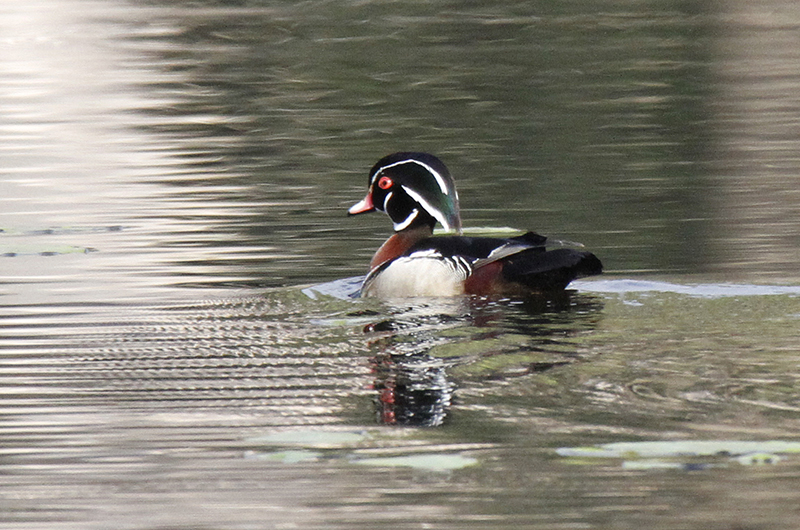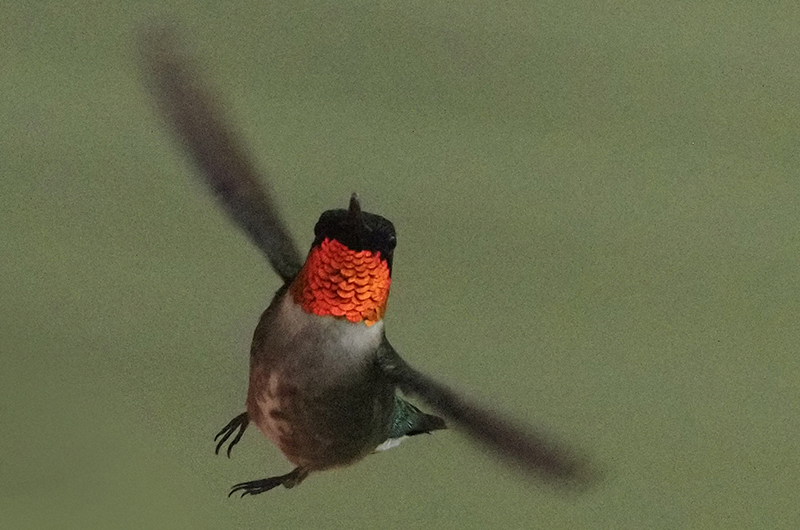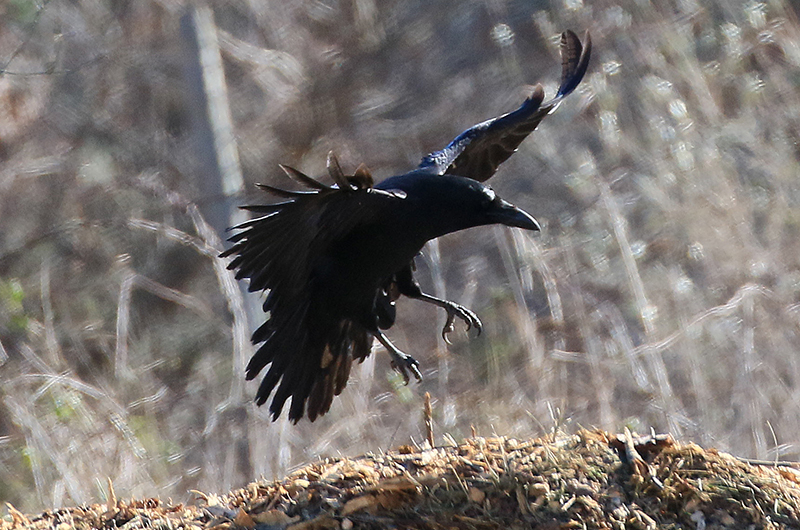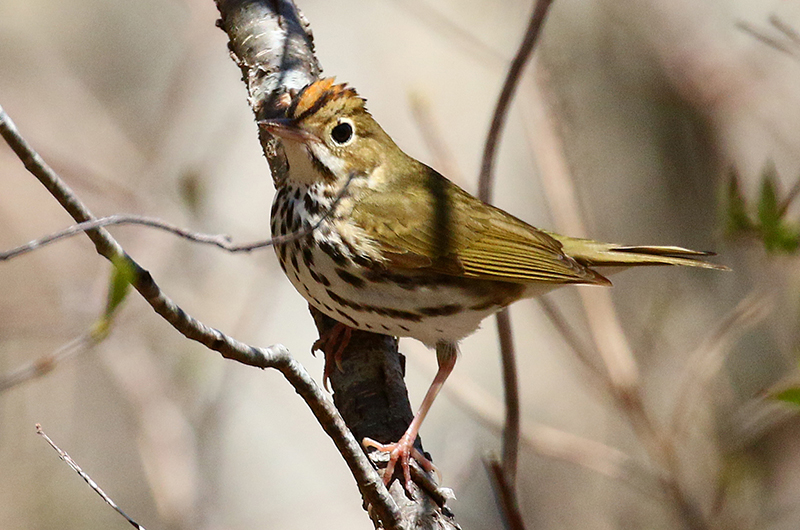It was a peaceful scene as I sat on a deck overlooking a lake in the northern Adirondacks, with spruce trees along the shoreline reflecting on the calm waters. Two striking black and white birds floated into sight and slowly cruised along the shoreline. After a few minutes the serenade began, a magical sounding yodel that defies the written word. The serenade lasted but five minutes before the two loons swam away across the lake, their summer home.
We see this species from October to May, though then they are mostly in their drab winter plumage. Their summer plumage is anything but drab, their crisp black and white patterns reflecting on the calm water. I have heard the yodeling occasionally on the Island, generally in April and May as they prepare to migrate to the still-frozen northern ponds and lakes where they nest.
A black-billed cuckoo was heard at Blackwater Pond Reservation by Caroline Heald on July 17. The call of these caterpillar specialists is distinctive and they are incredibly difficult to see: they often perch motionless in the upper parts of trees. Other species she observed there were great blue heron, mockingbird, cedar waxwing, pine warbler and scarlet tanager.
More conspicuous at this time of the year are eastern wood-pewee, great-crested flycatcher, eastern kingbird, and red-eyed vireo. Various combinations of these species have been reported by Susan Whiting on July 12 at the state forest headquarters and on July 13 at Old Fields Path in Chilmark; Al Sgroi and Steve Allen at Felix Neck on July 14; Bridget Dunnigan and Sea Williams at the state forest on July 14; Richard Couse at the Hoft Farm on July 15 and 16; Luanne Johnson along Katama Road on July 15; David McCartt along Beach Road in Oak Bluffs on July 15; at the Hoft Farm on July 16 by Caroline Heald, Matt Pelikan and Richard Couse; and by Caroline Heald at Chappaquonsett on July 16.
Recent warbler sightings include ovenbird, common yellowthroat, yellow warbler and pine warblers. They have been reported by Steve Allen and Al Sgroi and the Felix Neck Early Birders Program on July 14, Bridget Dunnigan and Sea Williams at the state forest on July 14, and Richard Couse at the Hoft Farm on July 16. These breeding species are more conspicuous now because they are still singing a lot.
At the Hoft Farm on July 13, Richard Couse heard a screech owl calling. He also saw a wood duck on July 15 and a scarlet tanager on July 16. David McCartt spotted three fish crows in Oak Bluffs on July 16. Luanne Johnson spotted two merlins — one a suspected fledgling and three house wrens — along Katama Road on July 15. Liz Toomey spotted two common ravens at the Tisbury Park and Ride on July 13.
Adult bald eagles were spotted by Benjamin Cabot at the West Tisbury School on July 15 and by Steve Allen at Felix Neck on July 12.
The shorebird numbers are increasing. Shea Fee spotted 18 piping plovers, two sanderling, three short-billed dowitchers, seven willets, five laughing gulls and six black skimmers on July 12 at Norton Point. On July 14 the Felix Neck Early Birders found two greater yellowlegs and one lesser yellowlegs. Walt Looney visited Little Beach on July 15 and reports nine American oystercatchers, 22 piping plovers, two ruddy turnstones, one sanderling, five least sandpipers, six semipalmated sandpipers, two short-billed dowitchers and five greater yellowlegs. Julia Austin spotted three baby piping plovers and one least sandpiper at Lucy Vincent Beach on July 15.
On July 16 at Norton Point Beach, Warren Woessner found five greater yellowlegs, three semipalmated plovers, and 25-30 semipalmated and least sandpipers. David McCartt birded Beach
Road from Oak Bluffs to Edgartown on July 16 and saw four least sandpipers, three semipalmated sandpipers, two greater yellowlegs and seven willets. That same day, Susan Whiting found two killdeer, one spotted sandpiper, four semipalmated sandpipers, six short-billed dowitchers, six greater yellowlegs, one lesser yellowlegs, two laughing gulls, one ring-billed gull and 14 common terns on Tisbury Great Pond.
Belted kingfishers are mentioned here for two unusual reasons. Marquisandro Robadel reports that, on July 14, a kingfisher hit a window but recovered and flew off. On July 17, Isaac Macy was on the beach at Makonikey and observed a kingfisher that was floundering at the water’s surface with a great black-backed gull attacking it; the outcome did not favor the kingfisher!
The male ring-necked pheasant that lives along Moshup Trail is still hanging around. It has been spotted by Tom Block and Dottie Poole and by India and John Goodridge. Their smaller cousin, the northern bobwhite, was spotted by Rebecca Brown along Meetinghouse Way on July 15 by Dan Polsby at Lobsterville Rd on July 14, and elsewhere earlier in July: on Dike Road by Lindsay Allison, near Edgartown Golf Course by Stephanie Tilton and Joan Jenkinson, in Menemsha by Barbara Armstrong, and in Edgartown by Wayne Jackson.
Finally, regarding the shearwaters that washed up on our beaches last month, the Rhode Island Department of Environmental Management reports that the die-off “is now thought to be unrelated to bird flu [and] It might have been starvation-related.” Just as Dick Veit first suggested and was reported in detail in this column! MassWildlife has yet to respond to my requests for their opinions.
Please email your sightings to birds@mvgazette.com
Robert Culbert is an ecological consultant with Nature Watch LLC living in Vineyard Haven.








Comments
Comment policy »